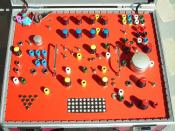Sound is a sensation that we hear. A sound originates in the vibration of an object. This vibration, in turn, makes the air or some other substance surrounding the object vibrate. The vibrations in the substance travel as waves, moving outward from the object in all directions. When the waves enter our ears, our organs of hearing translate them into nerve impulses. The impulses travel to the brain, which interprets them as a sound. The term sound also refers to the traveling waves.
Waves of sound can travel in any kind of substance. Most of the sounds that we hear travel in air, which scientists classify as a gas. But sound can also travel in liquids and solids. Sound travels most rapidly in solids, and more rapidly in liquids than in gases.
A substance in which sound waves travel is called a sound medium. Where no sound medium is present, there can be no sound.
There is no sound in outer space because outer space contains no sound medium.
This article discusses Sound (How some familiar sounds are produced) (The nature of sound) (How sound behaves) (Working with sound) (The study of sound).
How some familiar sounds are produced
The human voice is produced in the larynx, a part of the throat. Two small folds of tissue stretch across the larynx. These folds, the vocal cords, have a slitlike opening between them. When we speak, muscles in the larynx tighten the vocal cords, narrowing the opening. Air from the lungs rushes past the tightened cords, causing them to vibrate. The vibrations produce the vocal sounds. The tighter the vocal cords are, the more rapidly they vibrate and the higher are the sounds produced.
Animal sounds. Birds, frogs, and almost all mammals have vocal cords or similar structures. These animals...


